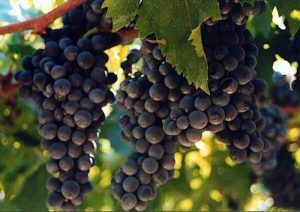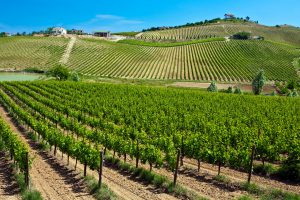
Montepulciano growing in Abruzzo
Montepulciano is a workhorse kind of grape, creating wines as a solo performer and in red blends. It also makes a damn fine rosé as well.
If Montepulciano is known at all, it is most frequently associated with its starring role in Montepulciano d’Abruzzo. This is easily understood as nearly half of the Montepulciano grown in Italy is utilized in the DOC of Montepulciano d’Abruzzo. This is no small number of bottles as Montepulciano is Italy’s second most widely planted red grape varietal behind Sangiovese.
Montepulciano d’Abruzzo has become very popular, and like most any popular wine, there are good and bad examples and, luckily, an increasing number of great wines.
Montepulciano d’Abruzzo has earned the reputation of often being cheap and cheerful. This distinction leads many consumers to the conclusion that Montepulciano is not a “serious” grape. Sadly, I, too, once believed this to be true.
Montepulciano can take on many different characteristics depending on where it’s grown, how it’s grown, and how it is treated in the winery. Oak aging is chief among the winemaking decisions that affect the resulting Montepulciano wines.
Typically Montepulciano offers moderate alcohol while delivering medium to full-bodied wines with medium-high acidity and body, as well as moderate tannins. The tannins can quickly multiply when new oak is used.
The Montepulciano Name Confusion
In the broadest of terms, Old World wines are named for places, and New World wines are named for grapes. Of course, there are exceptions.
Montepulciano is a bit of a head-scratcher for those learning Italian wines. Montepulciano is a grape and a famous wine town/appellation in Tuscany, most noted for Vino Nobile di Montepulciano DOCG. Like many of its Tuscan red brethren, Vino Nobile di Montepulciano DOCG is made with Sangiovese, not a drop of Montepulciano.
There’s not much that I can say other than, “Yes, that’s confusing.”
Italy is full of examples of wines being named for both the grape and the place linking them both in the process. A few examples include Barbera d’Alba, Fiano di Avellino, or Vernaccia di San Gimignano, among many others.
Montepulciano in Italy

Montepulciano Vineyards in Abruzzo
As previously mentioned, Montepulciano d’Abruzzo is the most widespread and popular of all the Montepulciano wines. (visit the Montepulciano d’Abruzzo Consorzio)
Abruzzo is a charming wine region in Central Italy located east across the Apennine range from Rome with the Adriatic Sea on its west. Abruzzo is known as the “greenest” region in Europe, as one-third of its territory is dedicated to nature reserves and parks.
As the wines of Montepulciano d’Abruzzo grew in popularity, a set of sub-zones within the DOC (what’s a DOC? see our Italian Wine Primer) have been identified. Top among these at this stage is Colline Teramane Montepulciano d’Abruzzo DOCG (the only DOCG wine from Abruzzo). The area of Colline Teramane Montepulciano d’Abruzzo is heavy with clay that is often beneficial to Montepulciano. Sadly, these wines rarely make it to the USA, and when they do, they are frequently twice to thrice the selling price compared to Italy.
Another emerging DOC for Montepulciano in Abruzzo is Controguerra. This is a small DOC, so finding wines here in the export market is difficult. Also, in Abruzzo, you will find the curious Cerasuolo d’Abruzzo (learn more here) a rosé wine made entirely with Montepulciano.
Marche is Abruzzo’s neighbor to the north. While Abruzzo is the undisputed king of Montepulciano it is the region of Marche that can boast two DOCG wines: Offida Rosso, and Conero. In addition to these appellations, Marche also offers the DOCs Rosso Conero and Rosso Piceno that are Montepulciano dominate blends with primarily Sangiovese in a supporting role.
Lazio, the home to the capital city of Rome, also grows a fair bit of Montepulciano. It is frequently used in red blends featuring in the Roma DOC, where it must comprise a minimum of 50% of the blend.
Montepulciano is also important in Molise, where it comprises a majority of the Biferno DOC, and in Puglia, where it is a minimum of the San Severo Rosso DOC pairing again with Sangiovese.
Montepulciano in The World
The grand majority — by leaps and bounds — of Montepulciano is grown in its native Italy. A growing number of acres are being planted in Australia and New Zealand.
Montepulciano is a bit of a novelty in the USA, with rumors of clusters in Texas or North Carolina and scant few plantings in California. Troon Vineyards makes a great 100% Montepulciano wine with grapes grown on their estate in Oregon.
While I would love to see more great wines made with Montepulciano, there is no value in having it planted where it does not belong. I’m fine with it being a primarily Italian creation.
